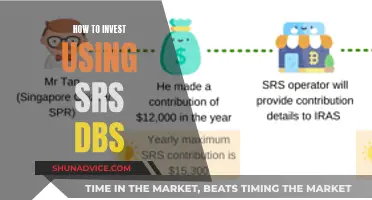Computers and mobile devices can be used to track investments, with many apps and software available to help investors monitor their portfolios. These tools can provide real-time information and performance analysis, helping investors make informed decisions about their investments. Some apps and software sync with existing accounts, while others require manual input of data. It is important for investors to keep track of their portfolio's performance and these tools can help them do so with ease.
| Characteristics | Values |
|---|---|
| Investment management software | Moneyspire, Empower, BankTree, Quicken, Moneydance, Mint, SigFig, WeVest, Sharesight |
| Investment management tools | Data aggregation, performance analysis, risk management, automation, decision support, compliance and reporting |
| Investment management software features | Portfolio tracking and management, performance analysis and reporting, risk management, integration capabilities, user interface and ease of use |
| Investment management software providers | Personal Capital, Wealthfront, Morningstar Direct, Betterment, YCharts, Quicken, Bloomberg Terminal, Tiller Money, eMoney Advisor, SigFig, M1 Finance, Portfolio Visualizer, Fundrise, Stash, Stock Rover |
What You'll Learn

Utilise portfolio trackers to monitor investments in one place
Portfolio trackers are a great way to monitor your investments in one place. These tools can be websites, apps, or software that allow you to monitor stocks, bonds, options, currencies, and more, across multiple accounts.
Empower (Formerly Personal Capital)
Empower is a popular choice for a portfolio tracker and is completely free to use. It offers a Financial Dashboard where you can add your credit cards, savings, checking accounts, loans, investments, and more, to track your net worth, spending patterns, and investment performance. Empower also provides access to additional tools like a retirement planner, net worth calculator, and budget planner. The Investment Checkup tool is particularly useful for assessing your portfolio's risk and analyzing past performance.
SigFig Wealth Management
SigFig is another well-known portfolio tracker that offers both a free and a fee-based version. The free version automatically syncs your investment accounts into a single dashboard, providing real-time information on your stocks, mutual funds, and exchange-traded funds (ETFs). The fee-based version allows users to create a personalized plan incorporating risk tolerance and time horizon for a small annual fee.
Sharesight
Sharesight is an excellent option for investors with international holdings. It tracks performance, dividends, and diversification across 50 international exchanges and over 100 global currencies. Sharesight shines in performance tracking, dividend tracking, tax reporting, and its ability to integrate with 200+ global brokers. The service is free for up to ten holdings or one portfolio, with additional features available for a monthly fee.
Yahoo Finance
Yahoo Finance offers a simple-to-use app that allows you to track stocks, commodities, bonds, and currencies. You can create and monitor the performance of your personal portfolio and sync multiple portfolios across all your devices. The app provides real-time stock information, personalized alerts, watchlists, and interactive charting.
Kubera
Kubera is a well-designed portfolio tracker that specializes in crypto, NFTs, and DeFi. It connects your global banks, crypto wallets, and brokerage accounts to provide a holistic view of your net worth. Kubera also automatically tracks the performance of stocks, bonds, and crypto, making it a comprehensive solution.
By utilizing these portfolio trackers, you can effectively monitor your investments in one place, making informed decisions, and staying on top of your financial goals.
Derivatives in Investment Banking: A Common Practice?
You may want to see also

Compare portfolio performance to market benchmarks
Computers and modern technology have made it easier than ever to track your investments and compare your portfolio performance to market benchmarks. Here are some ways to do this:
Excel and Spreadsheets
A spreadsheet tool like Microsoft Excel can help you track your portfolio and investments. You can create an investment tracking spreadsheet to visualize the performance of your stocks at a glance. Excel can also be used to calculate future performance and degrees of risk, profit, and loss. Additionally, you can connect Excel to real-time stock tracking information to always see the worth of your stocks.
Investment Apps
There are several mobile investment apps that offer real-time information on all your investments in one place. Some popular apps include Empower (formerly Personal Capital), SigFig Wealth Management, Sharesight, and Yahoo Finance. These apps can sync data from financial accounts and measure performance against a benchmark index or fund. They may also offer features like retirement tracking, asset allocation, and more.
Online Portfolio Trackers
There are many online portfolio trackers available, such as Kubera, Seeking Alpha, Stock Analysis, and Ziggma. These platforms can help you monitor your stocks, bonds, options, currencies, and more. Some are specifically designed for certain types of investors, such as international investors, dividend investors, or crypto investors.
Custom Benchmarks
When comparing your portfolio performance, it's important to use a benchmark that reflects your investment goals and asset allocation. You can create a custom benchmark of inexpensive index funds or ETFs that mirror your portfolio's asset allocation. This allows you to assess the performance of your security choices and determine if you could simplify or reduce costs in your portfolio.
Appropriate Benchmarks
When selecting a benchmark, it's crucial to choose one that aligns with your risk tolerance, investment goals, time horizon, and asset allocation. For example, if you have a retirement portfolio, you might allocate 65% to large-cap US stocks, 25% to international stocks, 5% to US bonds, and 5% to cash. In this case, you would want to compare the performance of your portfolio to benchmarks like the S&P 500 for large-cap US stocks and the Bloomberg Barclays US Aggregate Bond Index for US bonds.
Calculating Performance
To calculate your portfolio's performance, you can use formulas to determine the growth or return of your investments. Compare this to the growth you would have achieved if you had achieved the benchmark returns for each asset class. This will help you assess if your portfolio is performing as expected or if adjustments are needed.
By utilizing these computer tools and strategies, you can effectively track your investments and compare your portfolio performance to market benchmarks.
Robinhood Investing: A Beginner's Guide to Getting Started
You may want to see also

Use spreadsheets to visualise performance and calculate risk
Tracking investments using a computer can be done in a variety of ways. One of the most popular methods is to use a spreadsheet. With a spreadsheet, you can track the value of your stocks, mutual funds, ETFs, and more. You can also run custom reports, analyse trends, project your tax liability, and visualise retirement income scenarios.
For example, you can use Microsoft Excel to create an investment tracking spreadsheet. This allows you to visualise the performance of your stocks at a glance and calculate future performance and degrees of risk, profit and loss. You can also compare different types of investments across categories, futures, and types.
Excel can connect to real-time stock-tracking information so you can always see how much your stocks are worth. To get a stock quote, type in the name of the ticker symbol, then select Data > Stocks. Excel will automatically look up the ticker symbol or company and convert your cells to the stocks data type. The cells will display live stock information from Microsoft's online sources.
From there, you can add columns that will display information such as the number of shares, symbols, and closing prices.
- Investment information: Account name, stock ticker symbol, name of the investment, and category.
- Shares: The number of shares of each investment you own.
- Price and value: Connect to real-time online stock information or assign Excel functions for up-to-the-moment calculations.
- Break-even point: The price a stock needs to achieve to ensure a net income of zero. Anything beyond that is pure profit.
- Buying price: How much you paid for a stock per share.
- Commission: What you'll pay a brokerage service to buy or sell a stock.
- Tax rate: The long-term capital gains rate if you hold onto your stock for a long time, or a federal tax bracket if you sell before the end of the year.
- State income tax rate: An optional value that varies state by state.
You can also use spreadsheets to calculate investment risk. For example, you can calculate the equity risk premium for a security using Microsoft Excel. First, find the expected rate of return for the security and a relevant risk-free rate in the market. Then, enter a formula that subtracts the risk-free value from the expected value. By using Microsoft Excel spreadsheets, you can quickly swap out and compare multiple security rates.
Investing Activities: Statement of Cash Flows Impact
You may want to see also

Connect to real-time investment tracking
Microsoft Excel can be used to connect to real-time investment tracking. To do this, you can follow these steps:
- Type in the name of the ticker symbol.
- Select Data > Stocks.
- Excel will automatically look up the ticker symbol or company, then convert your cells to the stocks data type.
- The cells will display live stock information from Microsoft’s online sources.
- Add columns that will display other pertinent information, such as the number of shares, symbols, and closing prices.
This method allows you to visualize the performance of your stocks at a glance and calculate future performance, degrees of risk, profit, and loss.
Understanding Cash Flows: What's Not an Investment?
You may want to see also

Use investment management tools to make informed decisions
Investment management tools are essential for making informed decisions and optimising your investment portfolio. These tools offer a range of features, including data aggregation, performance analysis, risk management, automation, and compliance and reporting capabilities. Here are some ways investment management tools can help you make informed decisions:
Data Aggregation
Investment management tools allow you to aggregate all your investment accounts and holdings in one place, providing a comprehensive view of your financial position. This helps you monitor your investments within your financial portfolio, including stocks, bonds, mutual funds, and exchange-traded funds (ETFs).
Performance Analysis
Performance analysis tools help you assess the performance of your investment portfolios, identify trends, and track progress toward your financial goals. You can also calculate future performance and degrees of risk, profit, and loss, as well as compare different types of investments.
Risk Management
Investment management tools provide risk assessment and management features to help you identify, measure, and mitigate various types of investment risk. This includes market risk, credit risk, liquidity risk, and geopolitical risk. Additionally, stress testing allows you to simulate the impact of adverse market conditions or economic scenarios on your portfolio.
Automation
Many investment management tools offer automation features that streamline routine tasks such as data updates, portfolio rebalancing, and report generation, saving you time and effort. This helps you stay disciplined and patient by sticking to your investment strategy and avoiding impulsive decisions based on short-term market fluctuations.
Compliance and Reporting
Investment management tools help ensure compliance with regulatory requirements and provide customisable reporting capabilities for clients, stakeholders, or regulatory authorities. This includes generating reports on performance, key stats, fees, and holdings.
By leveraging investment management tools, you can make more informed decisions about your investment portfolio, optimising your investment strategy, and working towards achieving your financial goals.
Stash App: Invest in Legal Pot, Make Money
You may want to see also
Frequently asked questions
There are several good computer programs for tracking investments, including Microsoft Excel, Moneyspire, Empower, BankTree, Quicken, Moneydance, Mint, SigFig, WeVest, and Sharesight.
Using a computer program for tracking investments can provide an intuitive and comprehensive view of your financial portfolio, allowing you to monitor and manage your investments effectively. These programs can help you visualize the performance of your stocks, calculate future performance, and identify trends over time.
To get started, choose a suitable investment management software that meets your specific needs and budget. You can then follow the steps for implementation, including assessing your needs, selecting the software, migrating data, customizing the interface, and providing user training. Additionally, consider integrating the software with your existing systems for seamless data flow and workflow continuity.







